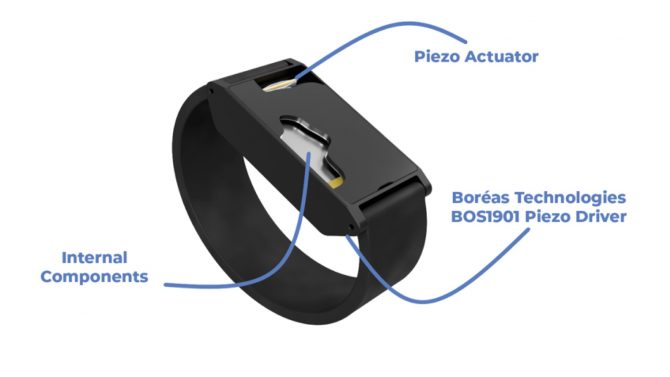
Boréas piezoelectric chip platform advances touch experience in wearables
EP&T Magazine
Electronics Engineering Wearable Technology Boréas chip Editor Pick haptic piezoelectric Sensor wearablesPiezo haptic engine brings HD haptics in tiny footprint to fitness trackers, smartwatches
Boréas Technologies, Bromont QC, unveiled its Boréas Piezo Haptic Engine (Boréas PHE), a module that harnesses the high performance of piezo actuators – solving wearable devices’ most significant challenge—achieving true high-definition (HD) haptic feedback in a broad range of low-power space-constrained devices.

The Boréas Piezo Haptic Engine uniquely enables tiny, low-power HD haptic feedback in wearables. Source: Boreas
The Boréas PHE is a major advancement over the two legacy technologies that have dominated haptics in wearables and other small devices: linear resonant actuators (LRAs) and eccentric rotating mass (ERM) motors, in which the quality of haptic performance is tied directly to the LRA’s or ERM’s volume and mass. This architectural approach makes these platforms too large to achieve a satisfying user experience in wearables. In contrast, the Boréas PHE uses a small off-the-shelf piezo actuator and the mass of other internal components to generate exceptional haptic performance, eliminating the size-power-performance trade-off typical of LRAs and ERMs.
“The quality of haptic effects in smartwatches and fitness bands is vital to the user experience. This makes choosing a high-quality haptic engine essential to customer satisfaction,” said Simon Chaput, founder and CEO, Boréas Technologies. “But the dominant actuators generally used in wearables, LRAs and ERMs, generate inferior haptic effects at the small size needed for wearables, making your device feel cheap.
“Piezo actuators, on the other hand, don’t have this problem. Used with our Boréas PHE, they produce stronger, more realistic, and more responsive haptic experiences that are sure to delight users with the premium feel that they’ve come to expect. Plus, their small size and ultra-low power consumption tick all the boxes for devices in which every millimeter and microamp are critical.” 
Outperforming LRAs in Wearables
The advantages of the BPHE over the LRA—the haptic technology most commonly used in wearables—is measurable.
- Larger Bandwidth—the BPHE creates stronger haptic effects within a larger bandwidth, from frequencies between 30-300 Hz, while small LRAs offer a narrow bandwidth at high frequencies (>200 Hz)
- Faster Rise and Fall Times—with rise times of 2.25 cycles vs. LRA’s 11 cycles, and fall times <10 ms vs. LRA’s 80 ms, the Boréas PHE’s faster response times enable sharper, more realistic haptic effects in wearables
- Low Power Consumption—the Boréas PHE is up to 10x more power-efficient than LRAs, extending battery lifetime
- Small Footprint—with a 12x4x1.8mm piezo actuator, the BPHE is small enough for volume-constrained devices
